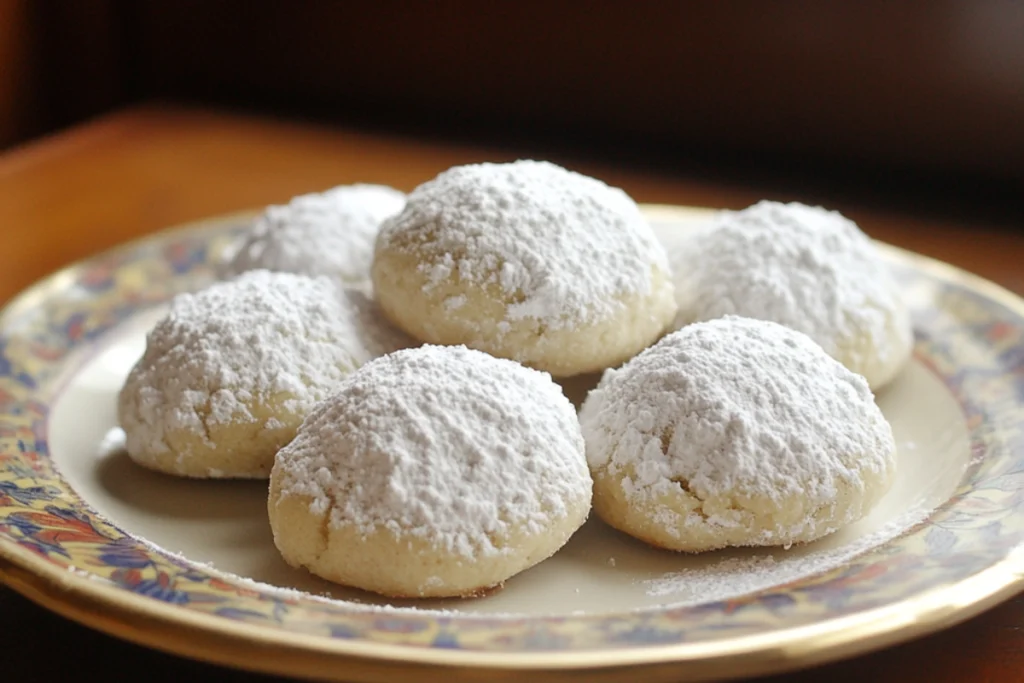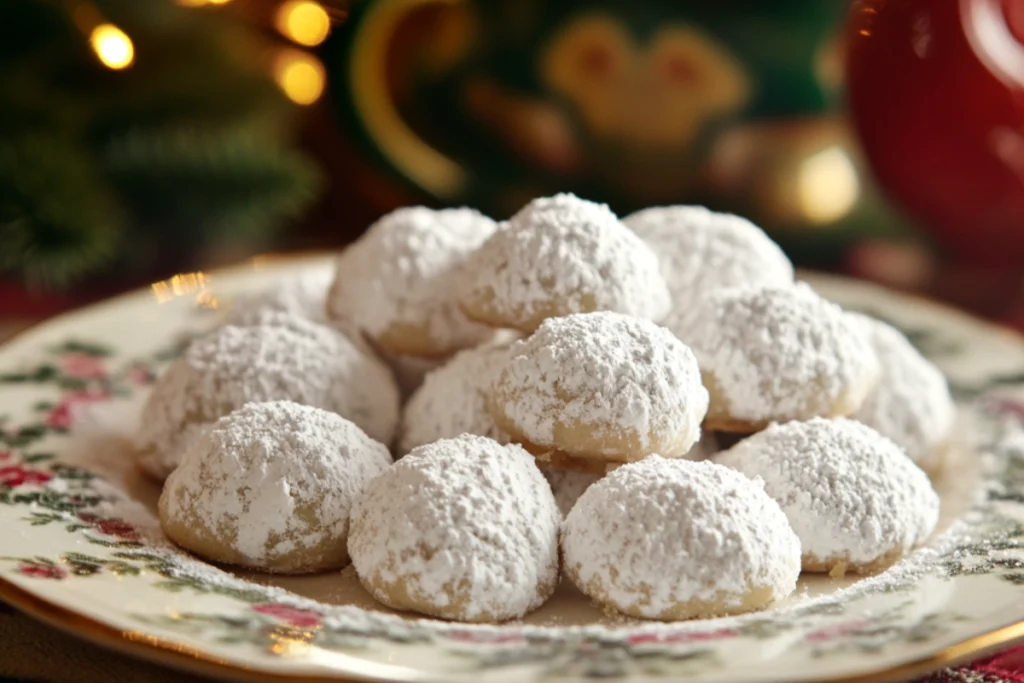Introduction to Mexican Wedding Cookies
Mexican Wedding Cookies also known as Polvorones or Biscochitos, are shortbread treats celebrated for their crumbly texture and sweet, buttery flavor. Coated in powdered sugar, these cookies have a festive appearance, making them a popular choice at weddings and celebrations around the world. Despite their name, Mexican dessert customs aren’t just for weddings; they are also enjoyed during holidays and special occasions.
So, what’s the story behind these delightful cookies, and why do they carry the name “wedding cookies”? The answer lies in a rich history of cultural and culinary tradition that spans continents and centuries. This article explores the origins of Mexican dessert customs, their cultural significance, and how they became a part of wedding traditions.
Historical Origins
The origins trace back to medieval Arab and European confections. Arab bakers in the Middle Ages crafted pastries using ground nuts, sugar, and spices—key ingredients in these cookies. These treats spread to Europe through trade and conquest, influencing baking traditions.
Spanish settlers brought a similar cookie called polvorón to Mexico. The term polvorón comes from the Spanish word polvo, meaning “dust” or “powder,” likely referencing the cookie’s crumbly texture and powdered sugar coating.
Linking Out: For more on the history of Mexican Wedding Cookies, visit this resource, which provides a detailed overview of their origins and evolution.
Why Are They Called Mexican Wedding Cookies?
The name “Mexican dessert customs” emerged more recently. During the Cold War, Americans distanced themselves from anything associated with Russia, including “Russian Tea Cakes,” as these cookies were previously known in the United States. The name change reflected their established presence at weddings and other celebratory events in Mexico.
Today, “Mexican dessert customs” is a widely recognized name, although these treats are known by various names depending on the region.
Linking Out: To explore more about Spanish Colonial Cuisine and its influence on Mexican baking, check out this detailed article.
Cultural Role in Weddings
In traditional Mexican weddings, hold significant symbolic value. They represent the joy of the occasion and the union of two families. The round shape of these cookies symbolizes the circle of life and eternity, making them especially fitting for weddings.
Sometimes, the bride and groom give them as favors to guests, symbolizing gratitude and best wishes. Their simplicity and elegance make a versatile addition to any wedding celebration.
Comparing with Global Variations
Share similarities with other treats around the world, reflecting their global influence:
- Although they share the name “wedding cookies,” their texture and flavor differ.
- Russian Tea Cakes: Similar to Mexican Wedding Cookies, Russian Tea Cakes are nearly identical in ingredients and preparation. The main difference lies in the name, influenced by cultural and historical contexts.
Modern Popularity and Recipe Variations
People make them for holidays, birthdays, and other celebrations. They have become popular for gift-giving as well.
Modern variations often include different types of nuts, such as almonds, walnuts, or hazelnuts. Some recipes add vanilla, cinnamon, or citrus zest for extra flavor. These adaptations show the cookie’s versatility and appeal to a wide range of tastes.
Bakers have also experimented with different shapes and sizes . While the traditional round shape remains popular, heart-shaped or star-shaped cookies are becoming common for special occasions.
Classic Recipe
Here’s a classic recipe for making your own :
Ingredients:
- 1 cup (2 sticks) unsalted butter, softened
- 1/2 cup powdered sugar, plus extra for coating
- 1 teaspoon vanilla extract
- 2 cups all-purpose flour
- 1 cup finely chopped pecans (or almonds)
- 1/4 teaspoon salt
Instructions :

- Preheat the Oven: Preheat your oven to 350°F (175°C). Line a baking sheet with parchment paper or a silicone baking mat.
- Cream the Butter and Sugar: In a large mixing bowl, beat the softened butter and powdered sugar until light and fluffy. This process will take about 2-3 minutes.
- Add Vanilla and Dry Ingredients: Mix in the vanilla extract. Gradually add the flour, chopped nuts, and salt, mixing until just combined. The dough will be thick.
- Shape the Cookies: Scoop out tablespoon-sized portions of dough and roll them into balls. Place the balls on the prepared baking sheet, spacing them about 1 inch apart.
- Bake: Bake the cookies for 12-15 minutes or until the bottoms are lightly golden. The tops should remain pale.
- Coat in Powdered Sugar: Let the cookies cool on the baking sheet for a few minutes, then roll them in powdered sugar while they are still warm. Once fully cooled, roll them in powdered sugar again for a thick coating.
Health Considerations and Ingredient Substitutions
While delicious, are rich, so enjoy them in moderation. However, there are several ways to make them healthier or suitable for different dietary needs:
- Healthier Ingredient Substitutions:
- Replace some or all of the butter with a plant-based butter substitute to reduce saturated fat.
- Use whole wheat flour instead of all-purpose flour to increase fiber content.
- Substitute half of the powdered sugar with a sugar alternative like stevia or erythritol.
- Gluten-Free Options:
- For gluten-free Mexican Wedding Cookies, use a gluten-free flour blend instead of all-purpose flour. Ensure that the powdered sugar and any flavorings are also gluten-free.
- Vegan Options:
- Replace the butter with a vegan butter substitute and use a plant-based milk if needed. Ensure that the sugar used is vegan-friendly.

FAQs olvorones history
- Why are they called?
- They got their name because they are traditionally served at weddings in Mexico and other Latin American countries. The name became more recognized, particularly in the United States.
- Do have to be made for weddings?
- No, Mexican Wedding Cookies can be enjoyed at any time. People often make them for holidays, birthdays, and other festive occasions, as well as for everyday snacking.
- What is the difference between Mexican Wedding Cookies and Russian Tea Cakes?
- The main difference is in the name and cultural context. The ingredients and preparation methods for both cookies are nearly identical, but the name “Mexican Wedding Cookies” has gained more popularity in the United States.
- How long do Mexican Wedding Cookies last?
- Mexican Wedding Cookies can last for up to a week when stored in an airtight container at room temperature.
- Can I freeze Mexican Wedding Cookies?
- Yes, Mexican Wedding Cookies freeze well. Place the cooled cookies in a single layer on a baking sheet to freeze. Once frozen, transfer them to a freezer-safe bag or container. To enjoy, thaw the cookies at room temperature or warm them in the oven for a few minutes.
Conclusion
Are a culturally rich treat that has captured the hearts and taste buds of people around the world. Their delicate flavor, crumbly texture, and festive appearance make them perfect for weddings and other special occasions. By understanding their history, cultural significance, and variations, we gain a deeper appreciation for their role in culinary traditions.
Whether you’re making them for a wedding, holiday, or just because, Mexican Wedding Cookies are sure to bring sweetness and tradition to your table. Try making them at home and enjoy a taste of history with every bite.

